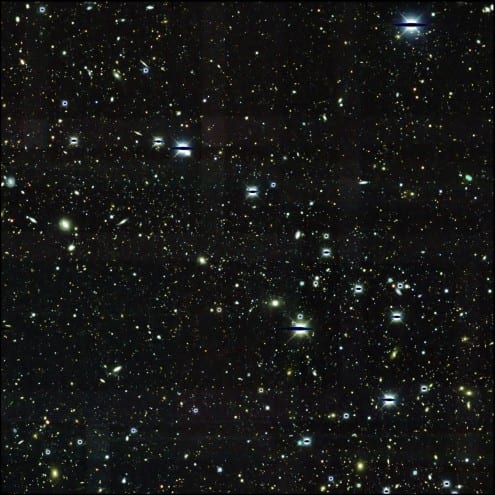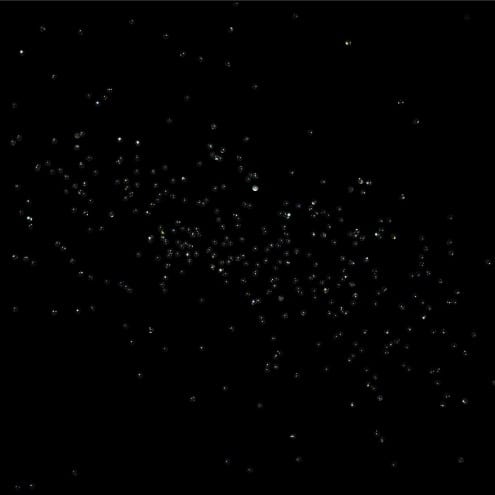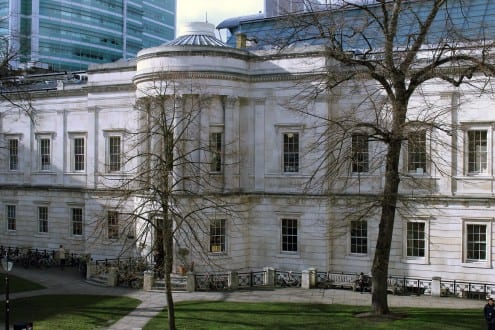This month we interviewed Dr Umber Cheema who works as Lecturer in In-Vitro Tissue Engineering at the Institute of Orthopaedics and Musculoskeletal Science, UCL. We asked her ten questions around her research, career and personal life and here is what she told us…
Solar eclipse
By Oli Usher, on 20 March 2015
The clouds didn’t part, but there was a great turnout for the eclipse party in the quad this morning. (So great that all the smartphones made eduroam a bit unreliable – sorry for the occasional breaks in the stream.)
Thanks everyone for coming – and see you for the next big one in 2026!
An Antarctic answer to a cosmic question
By Oli Usher, on 16 March 2015
It’s a setup worthy of Heath Robinson. In a faraway galaxy, a high energy cosmic ray interacts with a photon, producing a series of particle decays eventually releasing a neutrino. The neutrino then crosses billions of light years of space, punching through dust, gas and nebulae without effect. Eventually it reaches Earth, plunges through our atmosphere and finally meets something it cannot pass through: our planet.
When it reaches Earth, scientists hope to detect it. But the complications are only beginning.
High energy neutrino impacts are rare. A cubic kilometre of matter should typically see one roughly once every century. When it does, it triggers a brief and not particularly bright flash of microwave radiation – at the same wavelength and intensity as the flashes from piezoelectric cigarette lighters.
Detect these rare flashes, and you can detect the impact of neutrinos.
Scientists are patient people, and science is no stranger to large and expensive experiments. But building a detector of a cubic kilometre in size, far away from any sources of accidental interference – then waiting potentially a century or more to see a single result – is not reasonable.
Scientists need, somehow, to use the Earth itself as a giant detector, to increase the odds of seeing one.
Searching for somewhere remote enough that the faint signal doesn’t get drowned out, big enough to act as a natural detector, and dry enough not to absorb the microwaves, has taken UCL’s Ryan Nichol to Antarctica three times in the last decade.
There, ANITA (Antarctic Impulsive Transient Antenna), the instrument he works on, circles the South Pole, suspended from a balloon, monitoring a million cubic kilometres of ice for the telltale flash of microwaves that would signal a neutrino detection.
***
Scientists are targeting neutrinos because of what they tell us about cosmic rays.
Cosmic rays are fast-moving particles – usually protons and ions – that bombard the Earth’s upper atmosphere. Some of these move at exceptionally high speeds, up to 99.99999999999999999999% of the speed of light, giving them vast amounts of kinetic energy. A single one of these particles can have the same energy as a cricket ball travelling at 55 miles per hour. But frustratingly, their origins are shrouded in mystery. They must come from some kind of high-energy phenomenon – such as supernovae, black holes or the centres of galaxies – but we can’t figure out what.
Ultra-high energy cosmic rays can travel a long way, but they can’t travel infinitely far. They can interact with photons (light particles), which are everywhere in the Universe, even the vacuum between galaxies. This means that cosmic rays eventually – after about a hundred million light years – come to a halt.
As a result, all the cosmic rays detected in Earth’s upper atmosphere come from a region that includes our galaxy and a few neighbouring ones, but not from the hundreds of billions of galaxies that lie further away. This is by no means a small volume of space, and yet astronomers have come up empty handed when trying to pinpoint the origins of high energy cosmic rays within our cosmic neighbourhood. They need a way of broadening the search.
By looking for high energy neutrinos instead – which are launched like billiard balls by cosmic rays when they interact with photons, but which, unlike them, can cross the void of space without interacting – particle physicists like Nichol hope to extend the search radius from a few tens of millions of light years to several billion.
This should give them a large enough sample to begin to plot where the highest energy cosmic rays are coming from, and see if they can match this up with known objects in the sky that could be causing them.
But first, they need to develop a reliable way of spotting the neutrinos, which is where ANITA comes in.
And for ANITA to do its job, Nichol needs to get to Antarctica. Even in this age of easy international travel, this is not simple. Without any permanent inhabitants, Antarctica has no towns, isn’t visited by scheduled airlines, and even in the brief Antarctic Summer, is still cold and battered by extreme weather.
***
Nichol’s base of operations in Antarctica is McMurdo Station, the largest scientific research station on the continent. It looks like a cross between a mining town and a scruffy university campus – with halls of residence, cafeterias serving mediocre food, and social life centred on a few slightly disreputable bars.
Located on the coast, and served by several runways, McMurdo is one of the gateways to the constellation of smaller research stations dotted around Antarctica. Its summer population tops 1000 – not just researchers, but engineers, cooks, cleaners, drivers – but most of the scientists are just passing through, waiting for connecting flights to more remote stations where they will carry out their research.
For one group of scientists, though McMurdo is perfectly placed: those carrying out research using balloons. High in the sky above the base, a constant, predictable wind blows. Release a balloon into this, and it will gently float in a giant circle around Antarctica, before returning to where it started about two weeks later.
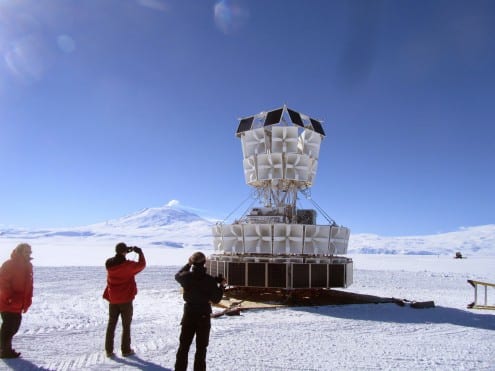
ANITA prior to being attached to the balloon. In the background, Mount Erberus, the second-highest volcano in Antarctica. Photo: Ryan Nichol
For the first couple of days after ANITA is released, McMurdo base is still in range. ANITA floats high in the atmosphere, around three times the altitude of commercial airliners, and so the base, with all the radio interference that comes from it, remains above the horizon for a long time. But once out of range, the only interference is the occasional chirp from communications satellites high above. ANITA silently watches the ice, recording vast amounts of data, and storing it for analysis later on.
The first two flights have not conclusively detected any high energy neutrinos yet. There has been one tentative detection, but the scientists would want to see several before being confident that they hadn’t just seen a false positive.

The flight of ANITA 3 in December 2014/January 2015. The path in red shows the balloon veering off course and ending its journey near Davis base.
This may all change soon. The third flight’s results are on their way home now – and taking a suitably convoluted route back. The December 2014 observations had to be cut short after the balloon blew off course, and the ANITA experiment was jettisoned onto the ice.

ANITA after crash-landing on the ice. Photo: © Josh F/Australian Antarctic Division
Rescued by helicopter and returned to an Australian base, ANITA is now waiting to board the icebreaker Aurora Australis for the journey to Tasmania. The research team hope to get it back next month.
The most recent ANITA mission featured more sensitive instrumentation than the previous two. Given this, the scientists are hopeful – though not certain – that they will get some more tangible results than previous years. They estimate that they should detect somewhere between 0 and 5 high energy neutrino events in this year’s data. So, barring bad luck, the planning, the cold and the years of hard work may just pay off.
***
So if you’re part of the ANITA team, that’s how you detect the highest energy cosmic ray in the Universe. All you need is for it to interact with a photon, emitting a neutrino that flies across billions of years of space before colliding with a water molecule, emitting a flash of microwaves. And for the flash of microwaves to be detected by a sensor suspended from a balloon floating 35km over the most remote and inhospitable region of the world, for the detection to be recorded onto a hard disk, for the hard disk to be dropped onto the ice, then rescued by helicopter, shipped by icebreaker and flown back to the lab, to be decoded by a physicist.
It’s simple, really.
Related links
- ANITA
- Ryan Nichol
- UCL High Energy Physics
- Article on the recovery of the ANITA instrument after its crash landing (including further photos)
Photos
Hiding in plain sight
By Oli Usher, on 12 March 2015
UCL has played a key role in the development of the Dark Energy Survey’s instrumentation, including building a series of lenses that form a crucial component of the Dark Energy Camera. UCL’s Ofer Lahav also serves as co-chair of the Dark Energy Survey science committee.
The Dark Energy Survey team published a new result this week that shows the power of the instrument.
The Milky Way is surrounded by a few dozen dwarf galaxies. Some of these are easy to spot, like the Large Magellanic Cloud, which is visible even to the naked eye as a pale blob in the Southern Hemisphere’s sky, clearly separate from the Milky Way.
Others are much harder to spot, as it is virtually impossible to distinguish their stars from the ones in the foreground, which are part of the Milky Way. Now, the Dark Energy Survey has discovered what appears to be several more. This image shows the challenge in identifying them:
The image shows one of the candidate galaxies, known as DES J0335.6-5403. It sits around 100,000 light years from Earth, and has very few stars, only around 300 could be detected, compared to an estimated 200 billion stars in the Milky Way.
The team were, however, able to analyse the image and mask all the stars that belong to our Milky Way. And when you do that, the dwarf galaxy suddenly jumps out at us:
Although UCL’s involvement in this study was only minor, it shows the power of the instrument and its contribution to the science over the past decade.
- Full details of the research can be found in a news story on the Fermilab website.
10 Questions
By ucqndko, on 11 March 2015
The Institute of Biomedical Engineering (IBME) interviews our researchers, academics, students, clinicians, affiliates and partners to find out a little more about who they are and what they do.
 1) What is your job title?
1) What is your job title?
Lecturer – In vitro tissue engineering.
2) What brought you to the world of science/engineering/medical technologies/medicine?
I always wanted to be a scientist, and during my PhD I developed a tissue engineered model of skeletal muscle. Following on from that I decided I wanted to be in the translational medicine field.
3) What is your favourite thing about your work?
The interaction I have with engineers, mathematicians, clinicians and surgeons means my work and science are varied, and I enjoy all the different perspectives it gives the research.
4) What do you feel are the main challenges facing your research at the moment?
The emphasis on conducting research which has an impact to wider society is now more critical than ever, but remains a challenge especially with the regulations in translational medicine.
5) How will you deal with these challenges?
Stay informed, talk to funding bodies including research councils and charities, keep close links with patient groups.
6) What’s been your career highlight?
I have 2 highlights: I was awarded a BBSRC David’s Phillips Fellowship in 2008; and my first PhD student passing her viva this November gone!
7) What is your favourite quote?
“When it’s dark enough you can see the stars.”
8) What do you do in your spare time?
I spend time with my boys – mostly at zoos and farms, or any place with animals.
9) What’s your favourite book at the moment?
Right now I’m reading ‘Istanbul’ by Orhan Pamuk and it paints a beautiful picture of the city.
10) If you had a superpower, what would it be and why?
Definitely being able to fly. Would massively help with getting from place to place quickly, and provide the perfect escape when things get too hectic.
Dr Cheema is Lecturer in in-vitro tissue, and previous to this she was a BBSRC David Phillips Fellow (2008-2013). Dr Cheema’s research is based on understanding cell behaviour and signalling in 3D collagen scaffolds. This work has resulted in close collaboration with industrial partners, including Oxford Optronix, on real-time O2 monitoring in 3D tissue engineered scaffolds and Sartorius, on development of biomimetic 3D tumour models. Dr Cheema’s recent research projects include (i) The development of a reproducible 3D in vitro model of tumour growth. Here the spatial architecture of a tumour and its surrounding stroma have been reproduced in vitro, with evidence of tumour invasion into surrounding ‘normal’ tissue; (ii) The development of engineered capillary beds for tissue engineered constructs; (iii) Development of tissue models to study decompression sickness.
Hydrophobic art
By Oli Usher, on 5 March 2015
Yau Lu (UCL Chemistry) is the lead author of some research which hit the headlines last week. His team has succeeded in making a water-resistant and self-cleaning coating which is both highly effective and very strong. Previous coatings have been weak, and easily scratched or flaked off.
Here, he shows how the hydrophobic paint can be used to create a water-repellent design on glass. The hydrophobic coating, water and dye all come together to create an ephemeral artwork:
Related links
High resolution image
Where noble gases won UCL a Nobel Prize
By Oli Usher, on 2 March 2015
Readers familiar with UCL will immediately recognise the Slade School of Fine Art – the North Wing on UCL’s historic (and grade I listed) quadrangle. What they may not know is that the building, which dates back to the 1870s, was originally also home to UCL’s Department of Chemistry.
It was in this building that some of UCL’s most famous contributions to chemistry were made: William Ramsay and his successor J Norman Collie both worked here.
In fact, as far as we can work out, it is the building in the world which has seen the discovery of the greatest number of chemical elements. Ramsay discovered argon, neon, krypton and xenon while working here, as well as isolating helium (which had been seen in the spectrum of the Sun, but not observed here on Earth) and radon. These elements are together known as the noble gases, and Ramsay’s discoveries secured for him the 1904 Nobel Prize in Chemistry – UCL’s first.
In 1913, the year of Ramsay’s retirement, UCL’s Chemistry department moved to a new purpose-built lab immediately behind its old home. The building – which still houses some of the department’s laboratories and offices – is now named after another towering figure in chemistry: Kathleen Lonsdale.
After a century of heavy use and piecemeal remodelling, the building is looking a little tired . A multi-million pound complete refurbishment of the building is planned to begin later this year.
Links
High resolution image
What’s wrong with this horse?
By ucqnjhw, on 24 February 2015
Two ponies, rendered using different computer hardware. The pony on the left is computed with an Intel CPU and looks normal. The one on the right is computed with an Nvidia GPU and looks buggy. Why do different hardware setups lead to different results? And how can this be tested?
Dr Jade Alglave (UCL Computer Science) has just been awarded a Royal Society prize for her work on testing and verifying different types of computer chip.
Chips by ARM, AMD, IBM, Intel, or NVidia are found in devices ranging from smartphones to supercomputers, cars to aeroplanes. Programming software to run on multiprocessors is a form of concurrent programming, where multiple computations are executed during overlapping time periods. Sadly, due to the great number of possible outcomes of a given program, concurrent programming is error prone and “buggy”, and difficult to test, as the picture shows.
Dr Alglave has developed a tool to test and model proprietary hardware which ensures that software runs consistently across a range of platforms, reducing delays and costs caused by errors and inconsistencies.
Exoplanets and education at 11 Downing Street
By Oli Usher, on 19 February 2015
Guest post by Anita Heward
The potential for exoplanet research to inspire students and widen participation at university from under-represented groups will be highlighted today at 11 Downing Street.
Dr Clara Sousa Silva, who completed her PhD at UCL last year, has been invited to give a four-minute presentation during an event hosted by the Chancellor for Your Life and Researchers in Schools (RIS). Clara is currently participating in the RIS teacher training and professional development programme.
The programme builds links between universities and schools by training researchers that have completed PhDs to become classroom teachers, while supporting them for 20% of their time to pursue academic interests. Clara is training as a physics teacher at Isleworth and Syon School for Boys and, through the RIS programme, is continuing aspects of her research into atmospheric characterisation of cool stars and exoplanets.
Clara also heads up the education programme for Twinkle, a UK space mission that will characterise exoplanet atmospheres using an instrument led by UCL.
EduTwinkle will draw on Clara’s experiences with RIS and the Brilliant Club to foster a productive relationship between space exploration and British schools, increase girls’ uptake of STEM subjects at A-level and higher education and to widen participation at universities from under-represented communities.
- Anita Heward is press officer for the Twinkle Space Mission
The art of unseeing
By Oli Usher, on 16 February 2015
While astronomers expend a lot of effort trying to see things better – building ever more powerful telescopes that can detect even the faintest, most distant objects – they are occasionally faced with the opposite problem: how to unsee things that they don’t want to see.
A group of scientists led by UCL’s Emma Chapman is working on methods to solve this problem for a new radiotelescope that is currently under development. In so doing, they could help give us our first pictures of a crucial early phase in cosmic history.
How to avoid seeing things you don’t want to see is a particular problem for cosmologists – the scientists who study the most distant parts of the Universe. Many of the objects and phenomena that interest them are faint, and lie hidden beyond billions of light years of gas, dust and galaxies. To make matters even more difficult, telescopes are flawed too – the data from them is not perfectly clean, which is manageable when you’re looking at relatively bright and clear objects – but a serious problem when you’re looking at the faint signature of something very far away.
Observing these phenomena is much like looking at a distant mountain range through a combination of a filthy window, a chain-link fence, some rain, clouds… and a scratched pair of glasses. In other words, you’re unlikely to see very much at all, unless you can somehow find a way to filter out all the things in the foreground.
***
The Square Kilometre Array (SKA) is a new radiotelescope, soon to begin construction in South Africa and Australia. The SKA will use hundreds of thousands of interconnected radio telescopes spread across Africa and Australia to monitor the sky in unprecedented detail and survey it thousands of times faster than any current system.
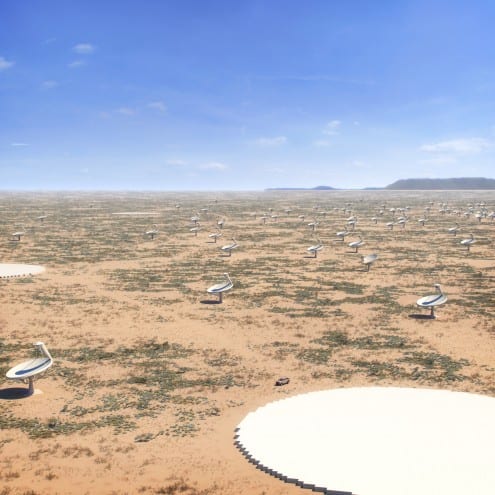
Artist’s impression of the South African site of the Square Kilometer Array. Credit: SKA Organisation (CC BY)
One of its objectives is to make the first direct observations of a brief phase of a few hundred million years in cosmic history known as the ‘era of reionisation’. This technical term conceals something quite dramatic: a profound and relatively sudden transformation of the whole Universe, which led to the space between galaxies being fully transparent to light as it is today.
10 Questions
By ucqndko, on 13 February 2015
The Institute of Biomedical Engineering (IBME) interviews our researchers, academics, students, clinicians, affiliates and partners to find out a little more about who they are and what they do.
This month we interviewed Professor Robert Brown who works as Professor of Tissue Engineering for the Institute of Orthopaedics and Musculoskeletal Science, UCL. We asked him ten questions to do with his research, career and personal life and here is what he replied…
 1) What is your job title?
1) What is your job title?
I am UCL’s first Professor of Tissue Engineering.
2) What keywords would you pick to describe your work?
Fun: Deeply Satisfying: Immensely Exciting – OR – Tissue Fabrication: Protein Materials: Collagen Cell Delivery: Angiogenic Materials.
3) What brought you to the world of science/engineering/medical technologies/medicine?
(i) A desire to make a difference to advanced healthcare; (ii) a drive to invent; (iii) the people in science and their fantastically diverse minds.
4) What is your favourite thing about your work?
Every day is different and the difference you can make – not least for the students and early stage researchers- is a joy!
5) What’s been your career highlight?
Inventing a method for rapid fabrication of living tissues that works (called plastic compression or ‘RAFT’), and understanding cell mechanics (OOPS) and scarring to the point where it was possible to invent a garment for reduction of pregnancy stretch marks.
6) What is your favourite quote?
“The wrong view of science is betrayed by a desire to be right” by Karl Popper.
7) What’s the best piece of advice you have been given?
Be careful where you are drilling.
8) Who has been your greatest mentor and why?
My father for instilling a love for new knowledge, and Paul D Byers (osteopathologist) for introducing me to the complexities of the scientific hypothesis.
9) What do you do in your spare time?
Walk and talk; with my dog Muttly or grandson Finn.
10) Finally, if you had a superpower, what would it be and why?
Super-vision (to see what people really need, or super-writing so that I could secure the grants I really wanted to do.
Professor Brown is a biochemist who turned to use protein materials for engineering of tissues and a network-generator with a foot permanently in two disciplines; He invents devices, using glimpses of effects which are surprisingly simple and basic.
 Close
Close








